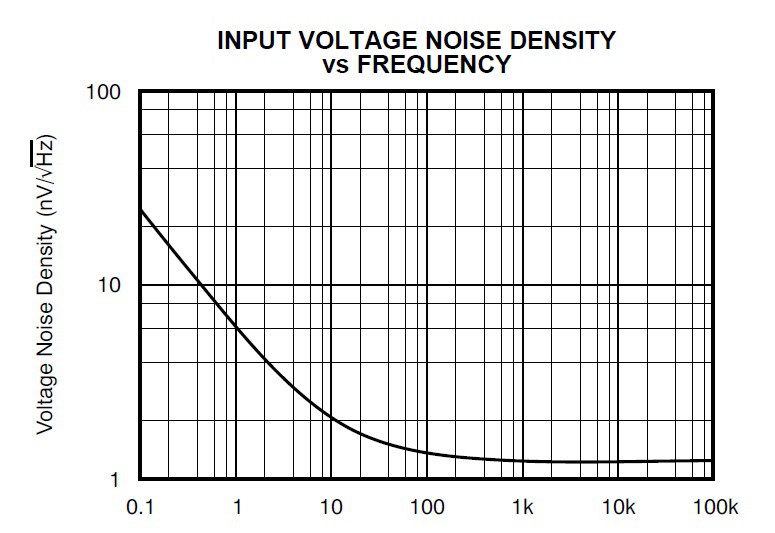Like the UCurrent, the heart of the design of The Low Voltage Translator is the amplifier [1]. To choose the best amplifier for this purposes, we need to know the priority of the amplifier specification needed.
The Low Voltage Translator wants to detect small signal until 10 uV. It means that we need the amplifier with input voltage noise peak to peak is 5% of 10uV to get 5% error of measurement. So, the next step is considering the best amplifier from low noise operational amplifier family.
I have discussed with some expert about the best low noise op-amp used for this purposes and they suggest me the OPA211. This is the figure of OPA211 voltage noise density referring to its datasheet [2]. We also neglect the current noise density of amplifier because we will use relative low resistance value of the resistors in the design [3].

Figure 1. OPA211 input voltage noise density.
Referring to Figure 1, OPA211 has 1.1 nV/(sqrt(Hz)) voltage noise density, one of the lowest voltage noise density op amp in the world. Besides that, total harmonic distortion (THD) of OPA211 also excellent, 0.00015%, one of the lowest THD op amp in the world.
The alternative for OPA211 is JRC4580 which also has low voltage noise density. This is the figure of JRC4580 voltage noise density referring to its datasheet [4].

Figure 2. JRC4580 input voltage noise density.
Referring to Figure 2, JRC4580 has 5 nV/(sqrt(Hz)) voltage noise density, it is good but slightly higher than OPA211. Besides that, total harmonic distortion (THD) of JRC4580 also good, 0.0005%, slightly larger than OPA211. Besides that, JRC4580 has the cheaper price than OPA211. It makes JRC4580 is preferable to first version prototype of The Low Voltage Translator to reduce the risk of failure.
The input voltage noise density value must be calculated to get input voltage noise RMS. From input voltage noise RMS, we can calculate the final result, the input voltage noise peak to peak. It must meet error specification of The Low Voltage Translator which is 5% of 10uV. In the next project log, we will propose the design schematic and calculating input voltage noise peak to peak to meet the specification of The Low Voltage Translator.
Reference
 Saaddin
Saaddin
Discussions
Become a Hackaday.io Member
Create an account to leave a comment. Already have an account? Log In.